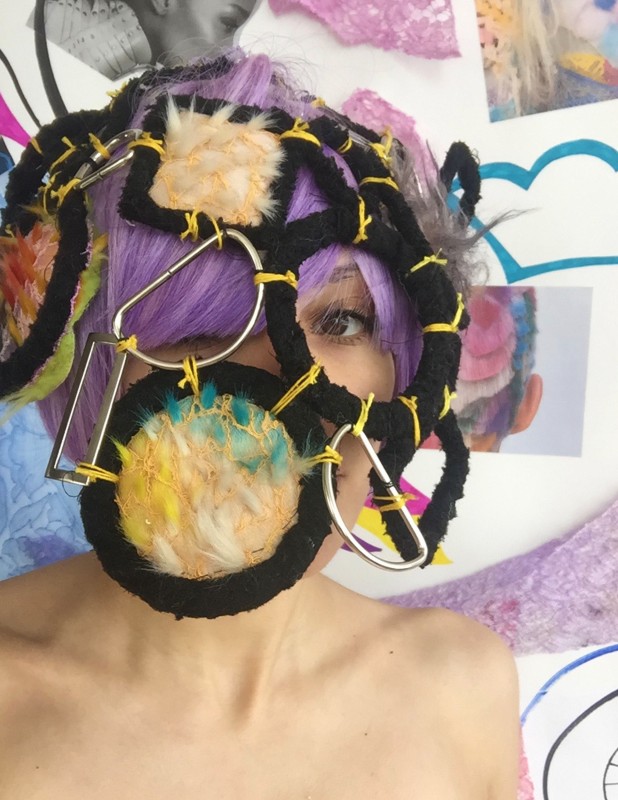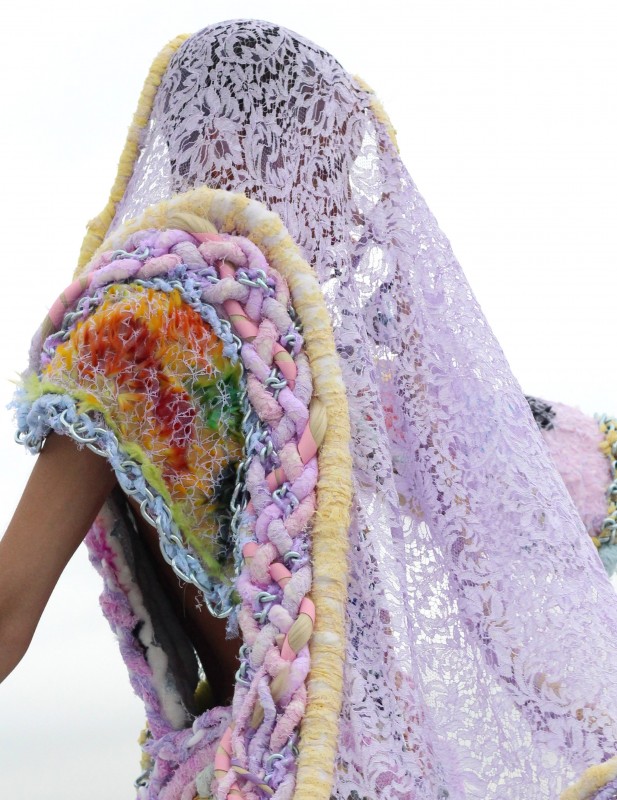.
Tara Al Wali – Parsons
Blurring Codes
SOPHIE HALLETTE : Where and how do you find your inspiration?
Tara AL WALI : I obtain my inspiration by pulling out whatever catches my eye or attention, from a magazine, iPhone pics, online or a book. It could be fifty images or just one photograph. For my Sophie Hallette project it coincidently was a haircut ! That marked the starting point for my work.
SH : Why did you choose to use lace?
TAW : Actually the Directors on the MFA program chose our groups for us, there were 3 groups assigned to the class, Lace, Swarovski and Ribbon. There was an intrigue to see what I could do with the lace since it’s not a fabric I would necessarily buy. I was happy to take up the challenge. I knew from the beginning that I wanted to use lace in a different way to it’s traditional ways. I wanted to develop textile techniques that would make you look at lace in a completely different way, that was what excited me the most.
SH : How did you work the lace?
TAW : I started working the lace with my first image of inspiration, which was a buzzcut hairstyle. Instinctively I bought fake fur! I used this as my “hair”. I shaved into the fake fur with a pair of clippers to mimic shapes from the floral lace; I also drew with marker pens the flower shapes from the lace design and onto the fake fur. I layered Sophie Hallette lace on top of the fur and pulled through small pieces like a hairdresser would pull hair through a highlighting cap!
From this point I just gathered hair references that inspired me visually and technically. I picked afro hair, mohawk hair, russian braids, dreadlocks, synthetic hair, poodle dog hair cuts and so on. I carried on replicating these hairstyles and interpreting them in my own way with the lace. I did not work with the lace gently but more so harshly. Cutting out strips, wrapping it around metal hoops and chains. That was how my process unraveled.
I dyed all my lace to achieve these pastel colour tones in my inspiration images. I dyed these at home in a pan in my kitchen. The chains came from punk mohawk references paired with russian braiding! I weaved lace in and out of the chains and then braided that with synthetic hair and my own made Sophie Hallette dreadlocks!
The dreadlocks were simply rope that I attached onto the lace and sewed with lace strips of the same fabric to cover the rope and secure it down. These were the pieces that became braids on the outfit. I continued to cut strips of lace and wrap that around the hardware to create huger lace.
All my textiles went onto the body later, the shapes of the textiles naturally found their way onto the body which is how I ended up with the final look. The headpiece has the metal placed in such a way that it balances completely on the head and shoulders on its own. I loved the contrast of heaviness with this delicate gentle fabric. The entire outfit weighs almost 25 pounds.
SH : What is the particularity of lace compared to other fabrics?
TAW : Compared to other fabrics lace has a small amount of stretch, which I actually really liked and could manipulate in my favour. I loved how the colours of the lace turned out with the dye, I was able to colour match with my research. Another particular component is that there was a rich variety of white lace which is wonderful for a dyer as it is like starting with blank canvases. I used both synthetic and natural fiber laces, I dyed these fabrics with a small amount of dye just to give those pastel tones, and it was a fun process!
I tried a few samples before I knew which shades I was going do, I also dyed a few different types of Sophie Hallette lace to see which lace I preferred the colours on. I liked the synthetic fabric results the most. The most obvious component of lace is that it is a light almost transparent material with decorative holes; it is very distinctive as a material however manipulating this as a designer is interesting as it is often associated with lingerie and evening wear.
SH : How did you combine your passion for dance with your lace?
TAW : To develop the shape and silhouettes of my design ideas I wore the textiles in a performative photoshoot. I used my body as a form of dance to play with these textiles, dancing and moving my body to see how these textiles can be worn and how they move and fall. I photographed this process.
The chained lace pieces kept dropping due to heavy weight. I had to search for the different points on my body that could balance the weight of these fabric samples. This became my head, under bosom, waist and shoulders. These features found their way into the final outfit and became the important parts of the body dictating the final design.
I have also performed in the outfit at a big event called The Latex ball in NYC. I won a Best Dressed award at that event in front of 7 judges and a huge live audience. I feel really flattered that my work is appreciated and recognized even by dancers and performers.
SH : What did you want to express through your creations?
TAW : As my textiles started to develop there was one question I asked myself, “how do I make lace look more aggressive?” This is in part what I wanted to express. The reason for this question was that firstly lace is delicate, sheer, floaty and a very labour intensive fabric to create! I wanted to see it in a completely different context to those buzzwords. Primarily for my own aesthetic but also because I myself do not identify with all those words, not all at once.
Whilst searching to make lace look harder, all the hardware started to make more sense. The metal I used and wrapped the lace around, really gave the textiles weight and determined where each piece of the outfit would fall and land on the body. None of the lace floated after my textile technique, that was what I wanted.
I pulled in inspiration from all types of hairstyles, the haircuts that inspired me were not just female haircuts but also male ones. A question to ask is; what is a male/ female haircut? It didn’t seem logical to then place this garment that had so many references to both genders on just one gender. I personally want to see my clothes on a diverse group of people and naturally felt it was important to photograph this look on one male and one female.
SH : What are your future projects?
TAW : My future project is my final collection at Parsons! I have my graduation in May 2019. I will be working on at least 8 looks for my final collection which will focus on diversity and all genders within a textile world. I come from a technical background of pattern-cutting so I intend to use that within my work moving forwards too.
I would also like to eventually perform, movement is important to me when wearing clothing and movement plays a big role in the process of my designs. I am taking one step at a time. It is exciting and nerve-racking!
SH : For you as a designer what is the future of lace?
TAW : The future of lace is endless within the world of craft, textile and technology. Lace can be replicated and appropriated in endless ways, lace does not need to be sheer and delicate. Lace can be 3D Cut, Laser Cut, Layered with fur, Covered in Resin, what if lace was made with a fine plastic yarn instead of cotton yarn and so on.
The traditional and artisanal way to make lace is timeless and of course significant, however with technology and creativity today so many other interpretations of lace can really be pushed. What if these traditional fabrics were replaced with new advanced man made materials. There are so many resources available today that were not available in the day and age of lace creation, for this reason I feel like the future of lace is ongoing.


Crédits photos : Tara Al Wali